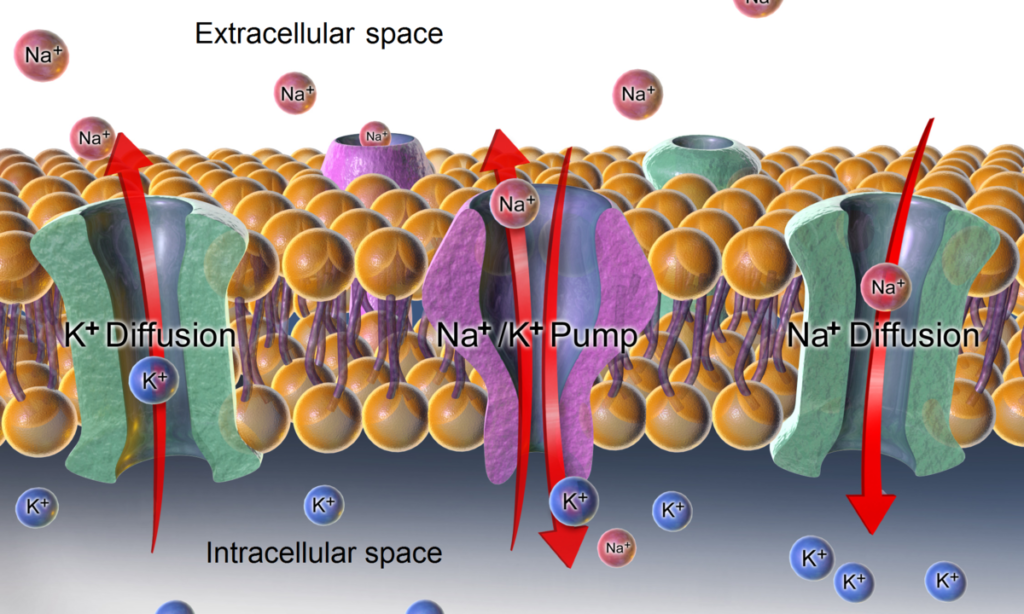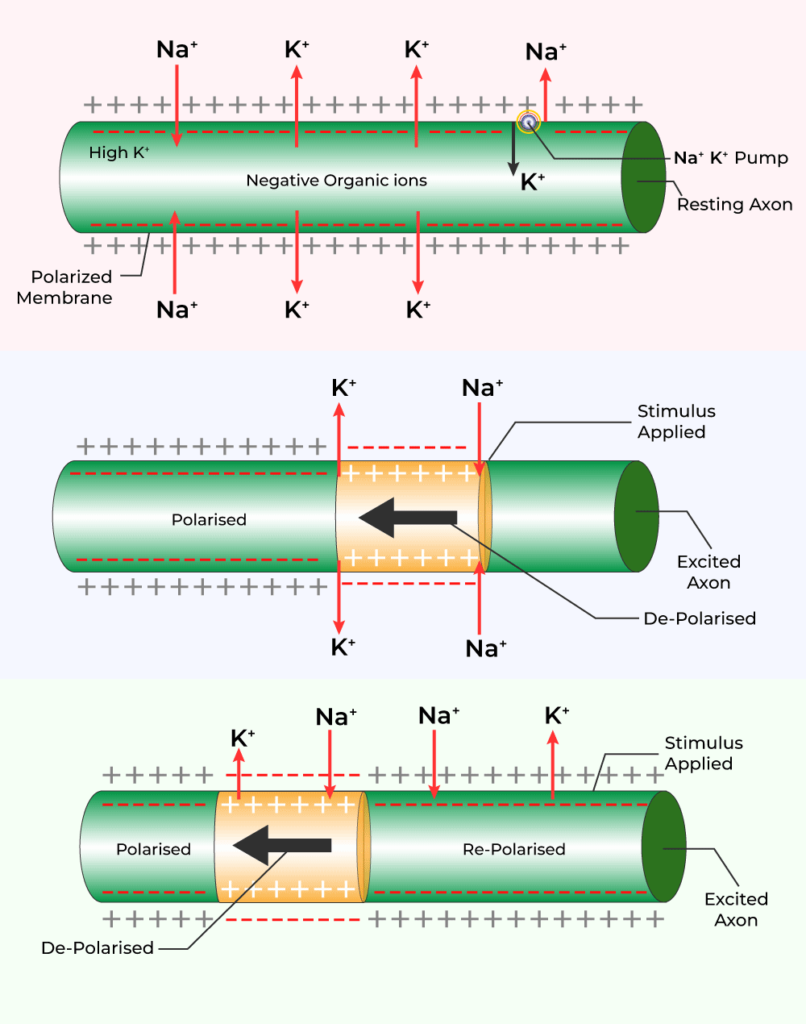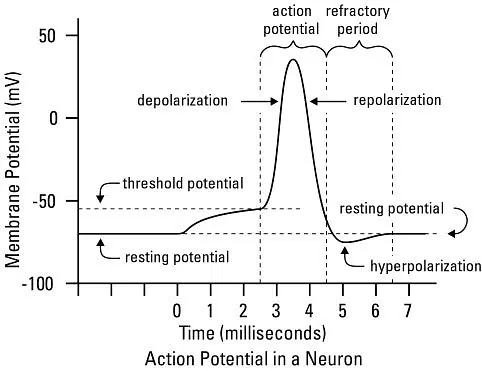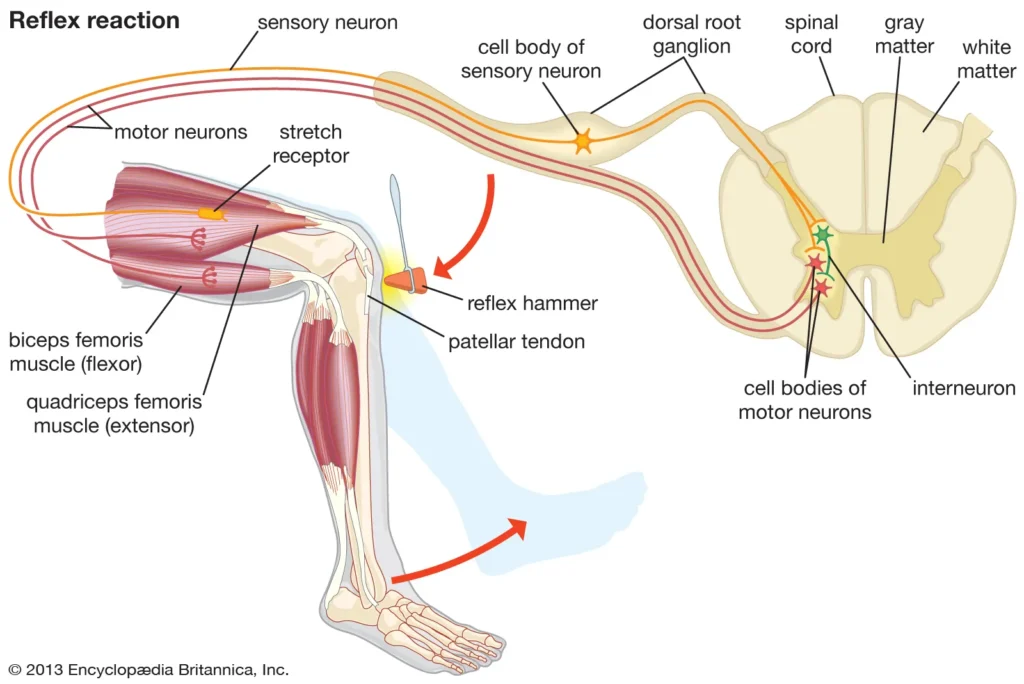INTRODUCTION
NEURAL CONTROL AND COORDINATION
- Coordination is the process through which two or more organs interact and complement the functions of one another to maintain homeostasis in our body.
- The neural system and the endocrine system jointly coordinate and integrate all the activities of the organs as that they function in synchronized fashion.
SYSTEM MAINTAINING HOMEOSTASIS
PARAMETERS NEURAL ENDOCRINE
SYSTEM SYSTEM
+ Integration Through Through
neurotransmitters hormones
+Coordination Quicker Slower
+ Neural system provides aan organised network of point to point connections with target cells.
NEURON
- Neuron is the structural and functional unit of the neural system.
- Composed of a cell body, dendrites and axon.
Types No. of Dendrites Location
Multipolar 2 or more Cerebral cortex
Bipolar 1 Retina of eye
Unipolar 0 Embryonic stage
Note:- -Above given neurons have only one axon.
– Cell body contains cell organnelles.
– Impulse from dendrites moves towards cell body and in axon away from cell body.

TYPES OF AXONS/NERVE FIBRES
Parameter Myelinated Non-myelinated
Myelin sheath + –
Node of Ranvier + –
Location Cranial & Autonomic and somatic
spinal nerves neural system
Note:- Schwann cells surrounded both myelinated and non-myelinated nerve fibres but they form myelin sheath only in myelinated fibres.
CONCENTRATION GRADIENT ACROSS AXONAL MEMBRANE
- Excitability of neurons is attributed to polarised state of neural membranes
- It has selectively permeable ionic channels responsible for deferential concentration gradient across the axonal membrane
- At rest, axonal membranes are more permeable for K+, nearly impermeable to Na+ and impermeable to negatively charged proteins.
Note:- Ionic gradients across resting membrane are maintained by the active transport of ions by the sodium-potassium pump which pumps 3Na+ outwards and 2K+ into the cell.

GENERATION OF IMPULSE
- The electrical potential difference across the resting plasma membrane is called the resting potential.
- The electrical potential difference across the axonal membrane after receiving threshold stimulus is called action potential/nerve impulse.

CONDUCTION OF IMPULSE
- impulse generated at a site arrives at another site and same sequence is repeated along the length of axon.
- Current flows in a circuit when it moves from A to B site.
- Flow of charge is from A → Inner→ B
← outer←
membrane

TRANSMISSION OF IMPULSE
Nerve impulse is transmitted from one neuron to another across a synapse.
Events observed:-
+Neurotransmitters released in synaptic cleft.
+Bind to receptors on post synaptic neuronal (PSN) membrane.
+Opening of ion channels in PSN
+Generation a new potential in PSN
Types of Synapse
Features Electrical synapse Chemical synapse
+Pre & post neuron Close proximity through Separated by fluid-filled
gap junctions synaptic
+Flow of impulse Direct Through neurotransmitters
+Transmission Faster Slower
+Nature — Excitatory or inhibitory
+Existence Rare Common
Note:- Transmission of impulse across electrical synapse is very similar to impulse conduction along a single axon.

NEURAL SYSTEM
- Neurons can detect, receive & transmit stimulus
+ Hydra- Network of neurons
+ Insects- Organised neural system with brain and ganglia
+ Vertebrates- Well developed neural system
HUMAN NEURAL SYSTEM
- CNS–Brain & spinal cord
- PNS– All nerves of body from brain and spinal cord
Nerve fibres of PNS
|_________________________|
Afferent Efferent
Afferent- Send impulses from CNS to skeletal muscles.
Efferent- Transmit impulses from CNS to peripheral tissues/organs
Efferent
|___________________|
Somatic neural system Autonomic nervous system
↓ ↓
Transmit impulses from Relays impulses from CNS to
CNS to skeletal muscles involuntary organs and smooth
musclesVisceral nervous system (VNS)
- Part of PNS
- Complex of nerves, fibres, ganglia and plexuses
- CNS→VNS← viscera
CENTRAL NERVOUS SYSTEM
- Acts as command and control system of the body
Protective coverings- Skull and Meninges
|_____________________________|
↓ ↓ ↓
Outer Middle Inner
+ Name of meninx Duramater Arachnoid Piamater
+ In contact with Skull Brain
Major Divisions of Brain:-
Divisions Major parts
+Forebrain Cerebrum, thalamus, hypothalamus
+Midbrain Corpora quadrigemina
+Hindbrain Pons, medulla, cerebellum
REFLEX ACTION AND REFLEX ARC
- Its response to peripheral nervous stimulation
- Involuntary i.e. without conscious effort
- Involves part of CNS.
Reflex pathway:-
Receptor–Afferent → CNS– Efferent → Effector /Excitor
neuron neuron
Note:-
- Neurons are arranged in series in a reflex pathway
- Afferent neurons transmit impulse via dorsal nerve root.
- Inter neuron is not a part of this stretch reflex.

BRAIN
- Brain is central information processing organ of the body
Forebrain:- - Cerebrum
+ Major part of brain
+ Cleft divides it longitudinally into right and left cerebral hemispheres, connected by corpus callosum - Thalamus
+ Major coordinating centre for sensory and motor signalling - Hypothalamus
+ Lies at base of thalamus
+ Has various centres for controlling body temperature, urge for eating and drinking
+ Secretes hormones.Midbrain
–Corpora Quadrigemina
+ Located between thalamus/hypothalamus and pons.
+ 4 lobs on dorsal side between forebrain and pons.
+ Integrates visual, tactile and auditory inputs– Cerebral Aqueduct
+ Canal passes through midbrainHindbrain
-pons
+ Fibrous tract that connects different regions of the brain.
– Cerebellum
+ Convoluted surface to accommodate more neurons.
+ Integrates information received from semicircular canal and auditory system.
-Medulla Oblongata
+ Connects brain to spinal cord
+ Has centres for controlling respiration, cardiovascular reflexes and gastric secretions.
Regions in cerebral Appearance Composition
hemisphere
+Outer/cortex Grey Concentrated cell bodies
Inner White Myelinated nerve fibres
The cerebral cortex includes:-
|______________|
↓ ↓
Sensory areas Motor areas Association areas
(Neither sensory nor motor)
↓ Functions
_______________________________________
↓ ↓ ↓
Inter sensory Memory Communication
associations
- Limbic system/Limbic lobe
+Parts included :- Inner part of cerebral hemisphere, hippocampus, amygdala and hypothalamus.
+ Functions:- Involved in expression of emotional reactions (e.g. excitement, pleasure, rage, fear)
+ Motivation
+ Regulation of sexual behaviour
+ Autonomic responses
+ Olfaction - Brain Stem is composed of Medbrain, Pons and Medulla Oblongata
Basic Functions of Brain - Controls the voluntary movements
- Balance of body
- Functioning of vital organs (kidneys, lungs, heart)
- Thermoregulation
- Controls hunger, thirst
- Circadian rhythms
- Human behavior
- Activities of endocrine glands.
FUNFACTS
Speedy Signals: Nerve impulses can travel at incredible speeds, reaching up to 268 miles per hour (431 kilometers per hour) in some of the largest nerve fibers.
Brain Power: The human brain is one of the most energy-intensive organs in the body, accounting for about 20% of the body’s total energy consumption, despite representing only about 2% of its total weight.
Neuron Diversity: There are estimated to be over 86 billion neurons in the human brain, each capable of forming thousands of connections with other neurons, resulting in a complex neural network.
Sleeping Brain: During REM (rapid eye movement) sleep, which is when most dreaming occurs, the brain is highly active and exhibits patterns of neural activity similar to those seen during wakefulness.
Fight or Flight: The sympathetic nervous system, part of the autonomic nervous system, prepares the body for action in response to perceived threats by increasing heart rate, dilating pupils, and releasing adrenaline.
Brainy Birds: Some bird species, such as parrots and crows, are known for their remarkable intelligence and problem-solving abilities. They have relatively large brains compared to their body size and exhibit complex social behaviors.
Mirror Neurons: Mirror neurons are specialized brain cells that fire both when an individual performs an action and when they observe someone else performing the same action. They are thought to play a role in empathy, imitation, and understanding the intentions of others.
Brain Plasticity: The brain has a remarkable ability to reorganize and adapt in response to experiences, learning, and injury. This neuroplasticity allows for lifelong learning and recovery from brain damage or trauma.
Brain Size vs. Intelligence: While brain size does correlate with intelligence to some extent across species, it’s not the only factor. The human brain is relatively large compared to body size, but intelligence is influenced by factors such as neural connectivity, organization, and efficiency.
Emotional Brain: The amygdala, a small almond-shaped structure deep within the brain, plays a crucial role in processing emotions such as fear, aggression, and pleasure. It is part of the limbic system, often referred to as the brain’s emotional center.

FAQs
- Disorders of neural control and coordination include neurological disorders such as Parkinson’s disease, Alzheimer’s disease, multiple sclerosis, epilepsy, and stroke, as well as psychiatric disorders such as depression, anxiety, and schizophrenia.
- The nervous system is highly adaptable and can undergo structural and functional changes in response to experiences, learning, and environmental stimuli. This adaptability, known as neuroplasticity, allows for learning, memory formation, and recovery from injury.
- Sensory pathways transmit sensory information from sensory receptors to the brain for processing and perception. Motor pathways transmit motor commands from the brain to muscles or glands to initiate a response or action.
he autonomic nervous system regulates involuntary bodily functions such as heart rate, digestion, respiration, and glandular secretion. It consists of sympathetic and parasympathetic divisions, which often have opposing effects on target organs to maintain homeostasis.
- The brain is the control center of the nervous system and coordinates various functions, including sensory perception, motor control, memory, emotion, and cognition. Different regions of the brain specialize in specific functions, such as the cerebrum for higher cognitive functions and the cerebellum for motor coordination.
2 thoughts on “Neural Control and Coordination Class 11 Notes”